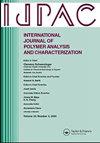电子束辐照聚乳酸/芦荟复合材料及其在可生物降解食品包装中的应用
IF 1.6
4区 工程技术
Q4 POLYMER SCIENCE
International Journal of Polymer Analysis and Characterization
Pub Date : 2025-07-04
DOI:10.1080/1023666X.2025.2478242
引用次数: 0
摘要
采用不同浓度- 1、2和3%的芦荟粉(AV),采用溶剂铸造法制备了聚乳酸/芦荟(PLA/AV)复合薄膜。所有复合材料分别暴露于10、25和40 kGy的电子束(EB)辐射下。研究了电子束辐射对聚乳酸/AV薄膜热力学特性的影响。采用XRD、FTIR、TGA、生物降解(土壤掩埋)等方法分析了辐照膜的特性。结果表明,高达25 kGy的剂量增加了纯PLA的拉伸强度(TS)。在低剂量至10千戈瑞时,加入AV可提高TS值(特别是在浓度为2%时)。结果表明,添加不同比例的AV粉末可以提高PLA/AV复合材料的热稳定性。生物降解性表明,含AV的膜生物降解性最好,不含AV的膜生物降解性最差。本文章由计算机程序翻译,如有差异,请以英文原文为准。
Electron beam irradiated composite based on poly (lactic acid)/aloe vera and its applications in biodegradable food packaging
Using Aloe Vera powder (AV) at varying concentrations − 1, 2, and 3% – polylactic acid/aloe vera (PLA/AV) composite films were prepared using the solvent casting process. All of the composites were exposed to 10, 25, and 40 kGy of electron beam (EB) radiation. It was examined how the thermal and mechanical characteristics of PLA/AV films were affected by electron beam radiation. XRD, FTIR, TGA, and biodegradation (soil burial) were used to analyze the irradiation films’ characteristics. The findings showed that doses up to 25 kGy increased the neat PLA’s tensile strength (TS). At lower doses up to 10 kGy, the addition of AV raises the TS values (particularly at 2% concentration). It appears adding varying proportions of AV powder enhances the thermal stability of PLA/AV composites. Biodegradability showed that films with AV were the most biodegradable, while those without AV were the least.
求助全文
通过发布文献求助,成功后即可免费获取论文全文。
去求助
来源期刊
CiteScore
3.50
自引率
5.30%
发文量
37
审稿时长
1.6 months
期刊介绍:
The scope of the journal is to publish original contributions and reviews on studies, methodologies, instrumentation, and applications involving the analysis and characterization of polymers and polymeric-based materials, including synthetic polymers, blends, composites, fibers, coatings, supramolecular structures, polysaccharides, and biopolymers. The Journal will accept papers and review articles on the following topics and research areas involving fundamental and applied studies of polymer analysis and characterization:
Characterization and analysis of new and existing polymers and polymeric-based materials.
Design and evaluation of analytical instrumentation and physical testing equipment.
Determination of molecular weight, size, conformation, branching, cross-linking, chemical structure, and sequence distribution.
Using separation, spectroscopic, and scattering techniques.
Surface characterization of polymeric materials.
Measurement of solution and bulk properties and behavior of polymers.
Studies involving structure-property-processing relationships, and polymer aging.
Analysis of oligomeric materials.
Analysis of polymer additives and decomposition products.

 求助内容:
求助内容: 应助结果提醒方式:
应助结果提醒方式:


